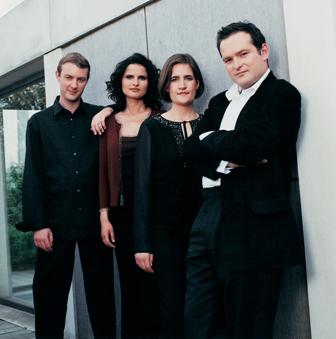
Belcea Quartet Brings Choice Program to Cincinnati
Chamber Music Cincinnati ended its 2009-10 season on a high
note April 27 in Robert J. Werner Recital Hall at the University of Cincinnati
College-Conservatory of Music.

As high, you might say, as violinist Corina Belcea-Fisher’s left hand on her Stradivarius violin.
Writing fine to the CMC season was the Belcea Quartet, a string quartet based at the Guildhall School of Music and Drama in London, also quartet-in-residence at the Atheneum Concert Hall in Bucharest, Romania. First violinist is Belcea-Fisher, a native of Romania, who founded the quartet in 1994 at the Royal College of Music in London. Second violinist and co-founder is Laura Samuel from England, violist Krzysztof Chorzelski is Polish and cellist Antoine Lederlin is French, making for a truly international configuration.
The Belcea Quartet came to Cincinnati with a considerable reputation preceding them, including some starry awards. They won the Gramophone Award in 2001 for best debut recording, were named Chamber Music Ensemble of the Year by Germany’s prestigious Echo Klassik Awards in 2008 and nominated for a 2008 Gramophone Award. They did not disappoint. Rarely has this reviewer heard a performance with such unity and depth of expression. Every aspect of the Belcea’s playing was focused on a common, intensely musical end: dynamics, tone color, vibrato, rhythmic and melodic inflection, even the way they held their instruments high (except cellist Lederlin, of course) and sat keenly poised on the edge of their seats. You could hear a pin drop in the hall monitoring their range of dynamics, which ranged from full-throated to whisper-soft.
They offered a choice program, Beethoven’s Quartet Op. 18, No. 6 (“Malinconia,” so named for the “melancholy” introduction to the final movement); Quartet No. 1, Op. 37 in C Major by 20th-century Polish composer Karol Szymanowski; and Bartok’s String Quartet No. 1.
Their Beethoven was vibrant from bar one, with every nuance in place, every phrase shaped just-so, all remarkably harmonious with their physical gestures and deportment. The Adagio was sweetly lyrical. The Scherzo moved along briskly, with keen rhythmic definition, close ensemble and abundant spirit. In the “La Malinconia” Adagio that opened the finale, they crafted a soft, grey sound. The forte chords that suddenly intruded were played without vibrato for a slashing, chilling effect. The ensuing Allegretto was steadfastly light and cheerful, interrupted twice by partial reprises of the mournful Adagio before a witty, Prestissimo run-up brought it to a happy end.
Szymanowski’s two string quartets, like the composer in general, are finally coming into their own. His Quartet No. 1, composed in 1917, is a creature of its time, trailing late German romanticism, with hints of Debussy, Ravel and East European folk music. Most likely new to most members of the audience in Werner Hall, it came across handsomely. Belcea-Fisher stole in quietly -- from high on the violin’s highest (E) string -- before engaging the other instruments in rhapsodic dialogue in the first movement. The second movement began somewhat similarly, turned passionate, then sank to near inaudibility. The musicians kept the thread clear at all times, Belcea-Fisher exploring the heights of her violin and helping to weave an overall contemplative spirit.
The third and final movement was a total contrast: vigorous and assertive with spiccato (bounced) rhythms and a brash, folk-like episode (think Bartok). It came to an end, somewhat surprisingly, on two soft pizzicato notes.
Composed in 1908, Bartok’s Quartet No. 1 is also indebted to late romanticism. He was 27 at the time and unhappily in love, which the music also reflects. The Belcea players filled the slow first movement with longing. There were agonized entries by violist Chorzelski (who poised his bow ominously in the air before engaging the string) and by Samuel on second violin, while Lederlin made the important cello pizzicato motif painfully percussive. The Allegretto second movement was heart-on-sleeve, with intense vibrato by all four instruments before resolving tenderly at the end. Lederlin’s solo at the beginning of the Allegro vivace finale was radiantly beautiful as the movement pushed toward an emotional resolution. Samuel (no shrinking violet all evening) introduced the Hungarian folk color that ultimately prevailed (all’s well that ends well?). Belcea-Fisher’s furious open E strings over roiling figures in the lower strings produced a sound you could sink your teeth into. She ventured high into the violin’s upper reaches once again and there were exuberant, whiplash gestures to the end.
Seen in the audience and backstage afterwards was Cincinnati violinist, concert:nova member Tatiana Berman, friend of Belcea-Fisher from the famed Yehudi Menuhin School in England and London’s Royal Conservatory of Music, where they both studied.
Chamber Music Cincinnati’s 2010-11 season was announced at the concert. There will be six concerts, opening with the Berlin Philharmonic Wind Quintet Oct. 5 in Robert J. Werner Recital Hall at CCM.
The complete schedule:
- October 5. Berlin Philharmonic Wind Quintet
- October 26. Trio con Brio Copenhagen
- December 7. Harlem String Quartet (Henry Meyer Memorial Concert)
- January 18, 2011. Escher String Quartet
- February 22, 2011. David Finckel, cello and Wu Han, piano
- April 5, 2011. Takacs String Quartet.
All concerts are at 8 p.m. in Robert J. Werner Recital Hall at CCM.
Subscriptions are $115 before June 1, $125 thereafter. Single tickets are $25. Tickets and information at www.cincychamber.org